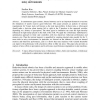Free Online Productivity Tools
i2Speak
i2Symbol
i2OCR
iTex2Img
iWeb2Print
iWeb2Shot
i2Type
iPdf2Split
iPdf2Merge
i2Bopomofo
i2Arabic
i2Style
i2Image
i2PDF
iLatex2Rtf
Sci2ools
CONNECTION
2004
2004
Evolving internal memory for T-maze tasks in noisy environments
In autonomous agent systems, internal memory can be an important element to overcome the limitations of purely reactive agent behaviour. This paper presents an analysis of memory requirements for T-maze tasks well known as the road sign problem. In these tasks, a robot agent should make a decision about turning left or right at the T-junction in the approach corridor, depending on a history of perceptions. The robot agent in simulation can sense the light intensity influenced by light lamps placed on the bank of the wall. We apply the evolutionary multiobjective optimization approach to finite state controllers with two objectives: behaviour performance and memory size. Then the internal memory is quantified by counting internal states needed for the Tmaze tasks in noisy environments. In particular, we focused on the influence of noise on internal memory and behaviour performance, and it is shown that state machines with variable thresholds can improve the performance with a hysteresis...
| Added | 17 Dec 2010 |
| Updated | 17 Dec 2010 |
| Type | Journal |
| Year | 2004 |
| Where | CONNECTION |
| Authors | DaeEun Kim |
Comments (0)

